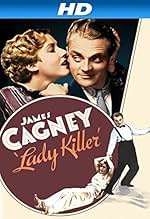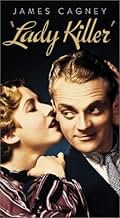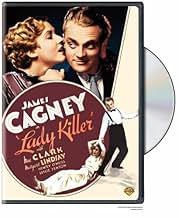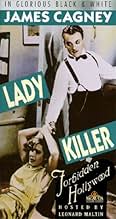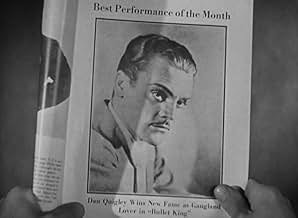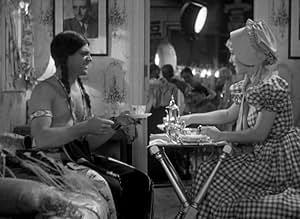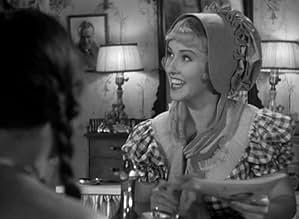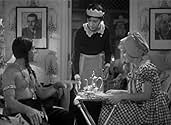ÉVALUATION IMDb
7,0/10
2,1 k
MA NOTE
Un ancien gangster réussit à Hollywood, mais son ancienne vie le rattrape.Un ancien gangster réussit à Hollywood, mais son ancienne vie le rattrape.Un ancien gangster réussit à Hollywood, mais son ancienne vie le rattrape.
- Prix
- 1 victoire au total
Douglass Dumbrille
- Spade Maddock
- (as Douglas Dumbrille)
William B. Davidson
- Director Williams
- (as William Davidson)
Lowden Adams
- Lois' Butler
- (uncredited)
Luis Alberni
- Director
- (uncredited)
Joseph Belmont
- Monkey Party Guest
- (uncredited)
Brooks Benedict
- Charlie - the Fence
- (uncredited)
Harry Beresford
- Dr. Crane
- (uncredited)
Avis en vedette
Jimmy Cagney plays a gangster in this film. However, despite having seen him play such a role in countless other films, this one is unique and well worth seeing because it STILL dares to be different.
Cagney is a wanted man back East, so he gets the idea of going to the West Coast to hang out and wait for things to die down. However, once there he is discovered by Hollywood and stars in gangster films because he is "so natural and believable". Well, despite his very shady past, Cagney tries to go straight and likes the life of a star. However, old associates realize who he is and try to blackmail him.
The film is a light comedy that invigorates the standard gangster genre. For its uniqueness and excellent acting and writing, the film gets an 8.
Cagney is a wanted man back East, so he gets the idea of going to the West Coast to hang out and wait for things to die down. However, once there he is discovered by Hollywood and stars in gangster films because he is "so natural and believable". Well, despite his very shady past, Cagney tries to go straight and likes the life of a star. However, old associates realize who he is and try to blackmail him.
The film is a light comedy that invigorates the standard gangster genre. For its uniqueness and excellent acting and writing, the film gets an 8.
Look out, world! Jimmy Cagney's coming to Hollywood and whether they use bullets or make-up the con artists haven't got a chance, in this raucous send-up featuring a New York crime boss who lands himself where the real action is – on a theater marquee.
Cagney is a wise guy named Dan Quigley who can't make it as a movie usher, so he raises his sights from lavatory dice games to breaking into rich folks' homes with the help of a nasty gang. When that goes bad and the gang leaves him flat, Quigley finds a new line in Hollywood, first as an extra, soon after as a "Famous He-Man of the Screen." But what will happen when the old gang shows up for a piece of the action?
The marquee in lights near the start of the film advertises someone called "The Prince Of Pep." He might as well be Cagney in this streamlined star vehicle, written entirely to showcase his fast patter and easy charm. Cagney's so good they don't even bother to build a coherent film around his character, and it hardly matters.
If you want to see a great Cagney film, there are perhaps a couple dozen better candidates. But if you want to see why the guy clicked so hard in the days of early sound, and still packs a punch 80 years later, this should be on your short list.
Cagney's lines here are priceless. To a dog being held by a theater manager who just fired him: "Listen, Fido, this guy's got a wooden leg. Try it sometime!"
To a group of card sharps who just cleaned him out: "I think I'll stick to checkers."
To the same group, after he's figured out their scam: "You kick back with my fifty bucks, or I'll fold your joint like an accordion!"
Just seconds later, he proposes a partnership. "You got a sweet racket here. Maybe I can show you a few new wrinkles."
"Lady Killer" was made just before the Hays Code was seriously enforced, which makes for interesting viewing. Reviewers here have already pointed out a scene when we see Quigley sneak Mae Clarke's character Myra a peck on the breast. The film takes even greater advantage of the liberal mores then still in effect by letting Quigley get away with his crimes. Sure, he goes straight, sort of, but only because he finds a better racket than potentially homicidal B&Es. There's no moment of Quigley coming to regret his wicked past, as censors would have required just months later.
That makes for a more entertaining Cagney vehicle, but a somewhat disjointed film. Director Roy Del Ruth keeps things moving quick, but in odd directions in tone, turning "Lady Killer" from a semi-serious gangster story to a genially goofy Hollywood satire. In his DVD commentary, Drew Casper calls "Lady Killer" a "shyster satire." It might also be called a "crooked comedy;" no one is on the level, whichever side of the law they're on.
So in Hollywood, we see Quigley break big after really slugging an extra in a mock prison break scene, and further his path toward stardom by faking fan letters. It's shallow stuff, but fun, especially as it all plays so fast. Other than the star, pacing is "Lady Killer's" ace in the hole.
Clarke should have graduated from the grapefruit league with this performance. She and Cagney resume their fireworks from "Public Enemy," this time with even more outrageous stunts, but Clarke, here the first- billed female, does wise work making sure we enjoy her comeuppance. Even her catty asides to Cagney, or the way she shamelessly plays with her hair while shaking him down for (more) dough, is on par with Barbara Stanwyck's star-making wickedness.
But make no mistake, "Lady Killer" is Cagney's baby, and he makes it work, despite the tone shifts and the odd title (Quigley's not a killer himself, and doesn't play with women's affections). You root for the guy despite his crookedness, and that's all that matters in the end.
Cagney is a wise guy named Dan Quigley who can't make it as a movie usher, so he raises his sights from lavatory dice games to breaking into rich folks' homes with the help of a nasty gang. When that goes bad and the gang leaves him flat, Quigley finds a new line in Hollywood, first as an extra, soon after as a "Famous He-Man of the Screen." But what will happen when the old gang shows up for a piece of the action?
The marquee in lights near the start of the film advertises someone called "The Prince Of Pep." He might as well be Cagney in this streamlined star vehicle, written entirely to showcase his fast patter and easy charm. Cagney's so good they don't even bother to build a coherent film around his character, and it hardly matters.
If you want to see a great Cagney film, there are perhaps a couple dozen better candidates. But if you want to see why the guy clicked so hard in the days of early sound, and still packs a punch 80 years later, this should be on your short list.
Cagney's lines here are priceless. To a dog being held by a theater manager who just fired him: "Listen, Fido, this guy's got a wooden leg. Try it sometime!"
To a group of card sharps who just cleaned him out: "I think I'll stick to checkers."
To the same group, after he's figured out their scam: "You kick back with my fifty bucks, or I'll fold your joint like an accordion!"
Just seconds later, he proposes a partnership. "You got a sweet racket here. Maybe I can show you a few new wrinkles."
"Lady Killer" was made just before the Hays Code was seriously enforced, which makes for interesting viewing. Reviewers here have already pointed out a scene when we see Quigley sneak Mae Clarke's character Myra a peck on the breast. The film takes even greater advantage of the liberal mores then still in effect by letting Quigley get away with his crimes. Sure, he goes straight, sort of, but only because he finds a better racket than potentially homicidal B&Es. There's no moment of Quigley coming to regret his wicked past, as censors would have required just months later.
That makes for a more entertaining Cagney vehicle, but a somewhat disjointed film. Director Roy Del Ruth keeps things moving quick, but in odd directions in tone, turning "Lady Killer" from a semi-serious gangster story to a genially goofy Hollywood satire. In his DVD commentary, Drew Casper calls "Lady Killer" a "shyster satire." It might also be called a "crooked comedy;" no one is on the level, whichever side of the law they're on.
So in Hollywood, we see Quigley break big after really slugging an extra in a mock prison break scene, and further his path toward stardom by faking fan letters. It's shallow stuff, but fun, especially as it all plays so fast. Other than the star, pacing is "Lady Killer's" ace in the hole.
Clarke should have graduated from the grapefruit league with this performance. She and Cagney resume their fireworks from "Public Enemy," this time with even more outrageous stunts, but Clarke, here the first- billed female, does wise work making sure we enjoy her comeuppance. Even her catty asides to Cagney, or the way she shamelessly plays with her hair while shaking him down for (more) dough, is on par with Barbara Stanwyck's star-making wickedness.
But make no mistake, "Lady Killer" is Cagney's baby, and he makes it work, despite the tone shifts and the odd title (Quigley's not a killer himself, and doesn't play with women's affections). You root for the guy despite his crookedness, and that's all that matters in the end.
"Lady Killer" represents a combination of talents Hollywood will never see again. There is fast talking James Cagney, who starts the movie as a dice playing, gum chewing usher who makes wise guy, but funny, comments to everyone. In Cagney's opening scene, he just makes it to a count out of the 25 ushers, held on the roof of the movie theater they work at. All wear Warner Bros. uniforms, including a cap with the WB logo on it. As Cagney advances in life, he becomes a partner in a gambling operation. One of his confederates slugged too hard a maid and almost kills her during a home robbery, another criminal activity Cagney's gang is involved in. Cagney tells the confederate (played by a snarling Leslie Fenton), what does he think, the police are dumbbells. Dumbbell was a favorite word of screenwriter Ben Markson, who used it to good advantage in another movie he co-wrote, "Gold Diggers of 1933."
Roy Del Ruth does his usual super job, cramming a ton of action into 76 minutes. There is one scene,where the cab of Mae Clarke's character is stopped at one of those old traffic devices, which has two signal vanes, one marked stop, and the other go. The stop signal goes up, another of Cagney's partners,Douglas Dumbrille, happens to be in the adjacent cab, he gets into Clarke's. He tells her "things are plenty hot in New York, I just jumped my bail and beat it out here by plane," to Los Angeles.
Meanwhile, Cagney is being questioned by the LA police, who previously picked him up at the train station on a New York warrant. Cagney tells the police chief, he went West for the climate, on account of his asthma. This scene represents the first mention I know of asthma in a mainstream movie. Later, after Cagney is sprung loose, Brannigan, the cop (played by Robert Elliot, almost typecast to cop roles in the 30s) who first pulled him in at the train station, tells him that if he doesn't find a job, he will be picked up as a "vag" (for vagrant) and get 30 days in jail.
When you look at this scene, notice the outline of the Venetian blinds on the office wall, and the dark shadows falling on the the faces of the Chief, Brannigan and Cagney's character. This scene, and the subsequent scene of Cagney trying to keep a low profile in a pool hall, unshaven and furtive, look as if they were from a film noir movie, only these scenes were made more than 12 years before the film noir cycle started.
The scenes showing Cagney working as a movie extra show how movies were made in the early 1930s, at least according to Roy Del Ruth. There is a scene of Cagney as an Indian chief on an imitation horse riding in front of a back projection screen, the movie director shouting, with a heavy European accent, "Ride, That A Boy!" Later, on a 15 minute lunch break, box lunch in hand, Cagney identifies himself to his future girlfriend, Margaret Lindsay as a Chief with the name, said in Yiddish, Pain In The Ass. I could be off in the translation, but Cagney used a Yiddish phrase.
The movie plot has one unexpected connection to real life. In 1939, there was a New York gangster named Greenbaum, nicknamed "Big Greenie." As I recall, from reading Burton Turkus's book, "Murder, Inc." years ago, Greenbaum fled to the West Coast, where he worked as an extra in movies while avoiding Lepke's killers. Greenbaum knew too much, and Lepke eventually managed to have "Big Greenie" killed.
"Lady Killer" was made in 1933 fast, by great talents. I saw it playing the laserdisc of the movie, part of the double laserdisc of James Cagney movies that Image released in 1992. The second movie on the LD set, "Blonde Crazy," made in 1931, is good also, but the advances made in movie making in two years are really something, comparing the two movies.
There is only one slight flaw in "Lady Killer." In every other pre-Code movie I saw from Warner Bros., when someone reads a telegram, you see the telegram message on screen, the telegram made by the prop department. When the LA police chief shows a telegram to Cagney, explaining the situation, he tells him New York authorities asked him to hold Cagney's character. You never see the actual telegram message, Warners usual practice then, a practice not usually followed by other studios. Maybe Warners' prop department did prepare a fictitious telegram but movie director Roy Del Ruth thought it looked "fakey."
Roy Del Ruth does his usual super job, cramming a ton of action into 76 minutes. There is one scene,where the cab of Mae Clarke's character is stopped at one of those old traffic devices, which has two signal vanes, one marked stop, and the other go. The stop signal goes up, another of Cagney's partners,Douglas Dumbrille, happens to be in the adjacent cab, he gets into Clarke's. He tells her "things are plenty hot in New York, I just jumped my bail and beat it out here by plane," to Los Angeles.
Meanwhile, Cagney is being questioned by the LA police, who previously picked him up at the train station on a New York warrant. Cagney tells the police chief, he went West for the climate, on account of his asthma. This scene represents the first mention I know of asthma in a mainstream movie. Later, after Cagney is sprung loose, Brannigan, the cop (played by Robert Elliot, almost typecast to cop roles in the 30s) who first pulled him in at the train station, tells him that if he doesn't find a job, he will be picked up as a "vag" (for vagrant) and get 30 days in jail.
When you look at this scene, notice the outline of the Venetian blinds on the office wall, and the dark shadows falling on the the faces of the Chief, Brannigan and Cagney's character. This scene, and the subsequent scene of Cagney trying to keep a low profile in a pool hall, unshaven and furtive, look as if they were from a film noir movie, only these scenes were made more than 12 years before the film noir cycle started.
The scenes showing Cagney working as a movie extra show how movies were made in the early 1930s, at least according to Roy Del Ruth. There is a scene of Cagney as an Indian chief on an imitation horse riding in front of a back projection screen, the movie director shouting, with a heavy European accent, "Ride, That A Boy!" Later, on a 15 minute lunch break, box lunch in hand, Cagney identifies himself to his future girlfriend, Margaret Lindsay as a Chief with the name, said in Yiddish, Pain In The Ass. I could be off in the translation, but Cagney used a Yiddish phrase.
The movie plot has one unexpected connection to real life. In 1939, there was a New York gangster named Greenbaum, nicknamed "Big Greenie." As I recall, from reading Burton Turkus's book, "Murder, Inc." years ago, Greenbaum fled to the West Coast, where he worked as an extra in movies while avoiding Lepke's killers. Greenbaum knew too much, and Lepke eventually managed to have "Big Greenie" killed.
"Lady Killer" was made in 1933 fast, by great talents. I saw it playing the laserdisc of the movie, part of the double laserdisc of James Cagney movies that Image released in 1992. The second movie on the LD set, "Blonde Crazy," made in 1931, is good also, but the advances made in movie making in two years are really something, comparing the two movies.
There is only one slight flaw in "Lady Killer." In every other pre-Code movie I saw from Warner Bros., when someone reads a telegram, you see the telegram message on screen, the telegram made by the prop department. When the LA police chief shows a telegram to Cagney, explaining the situation, he tells him New York authorities asked him to hold Cagney's character. You never see the actual telegram message, Warners usual practice then, a practice not usually followed by other studios. Maybe Warners' prop department did prepare a fictitious telegram but movie director Roy Del Ruth thought it looked "fakey."
If you like James Cagney, and I sure do, you'll love this comedy melodrama from the pre-code years at Warner Brothers. Cagney portrays a cheap hoodlum who falls in with a gang of petty con artists, gets wrapped on the knucklesl by the long arm of the law, and winds up becoming a movie matinee idol. It's fun all the way, with enough wise-cracking dialogue, rapid action, car chases, gunfire, and double-dealing to satisfy any fan of the early gangster films, yet it's a lively, tongue-in-cheek comedy from start to finish. Enjoy!
New York criminal (James Cagney) takes it on the lam and winds up in Hollywood. There he gets a job working in movies, first in bit parts and eventually as a leading man. But when his old gang hears about his newfound success, they come knocking on his door and risk ruining everything for him.
I hesitate to call this a gangster picture like everybody else seems to be doing. Cagney's character starts out the movie joining a gang but it's a gang of confidence men. Then they graduate to robbing houses before someone is shot and they have to leave town. These aren't racketeers or guys shooting it out with tommy guns. So, in my view, they're criminals for sure but not what I would call gangsters. Not that it matters much in the end. This movie reunites Cagney with his Public Enemy costars Mae Clarke and Leslie Fenton. Clarke is a treat to watch and has great chemistry with Cagney. Lovely Margaret Lindsay plays the movie star Cagney falls for. I'm a fan of hers so of course I enjoyed her in this. Highlights include Cagney dragging Clarke out of his room by her hair and Cagney forcing a movie critic to eat his own review. A fun crime comedy from Warner Bros. with another great Cagney role.
I hesitate to call this a gangster picture like everybody else seems to be doing. Cagney's character starts out the movie joining a gang but it's a gang of confidence men. Then they graduate to robbing houses before someone is shot and they have to leave town. These aren't racketeers or guys shooting it out with tommy guns. So, in my view, they're criminals for sure but not what I would call gangsters. Not that it matters much in the end. This movie reunites Cagney with his Public Enemy costars Mae Clarke and Leslie Fenton. Clarke is a treat to watch and has great chemistry with Cagney. Lovely Margaret Lindsay plays the movie star Cagney falls for. I'm a fan of hers so of course I enjoyed her in this. Highlights include Cagney dragging Clarke out of his room by her hair and Cagney forcing a movie critic to eat his own review. A fun crime comedy from Warner Bros. with another great Cagney role.
Le saviez-vous
- AnecdotesFor the scene when Dan Quigley hauls Myra Gale across the apartment floor by her hair and throws her out the door, James Cagney taught his co-star Mae Clarke an old stage trick. When Cagney grabbed hold of Clarke's hair (holding her by the top of her head), Clarke reached up and grabbed Cagney's wrist with both hands. This put her weight on Cagney's wrist, instead of on her hair. Clarke then held on to Cagney's wrist, screaming, as he dragged her across the room.
- GaffesAfter the robbery of the wealthy woman's home, the paper says a maid was struck and seriously injured, and later in Dan Quigley's office, they're still talking about a maid who screams. Later, when the guy who actually hit her comes back scared, he says the butler died.
The owner of the house where Dan was taken after the "car accident" was Mrs. Wilbur Marley. This was the house where the maid was "slugged". The butler who "croaked" was "on the Crosby job".
- Citations
Spade Maddock: [discussing diamond-studded Mrs. Marley at the gang's speakeasy] C'mere - take a gander at her.
Dan Quigley: [eyeing her through a peephole] Did you say "gander?" I wonder how she'd go for a goose.
- ConnexionsFeatured in Hollywood: The Great Stars (1963)
- Bandes originalesIsn't It Heavenly
(1933) (uncredited)
Music by Joseph Meyer
Lyrics by E.Y. Harburg
Played when Myra invites Dan into her apartment.
Meilleurs choix
Connectez-vous pour évaluer et surveiller les recommandations personnalisées
- How long is Lady Killer?Propulsé par Alexa
Détails
- Date de sortie
- Pays d’origine
- Langues
- Aussi connu sous le nom de
- The Finger Man
- Lieux de tournage
- Hinman Hotel, 7th Street and Figueroa Street, Los Angeles, Californie, États-Unis(The opening scene with the theater manager addressing his ushers in military formation is filmed on the rooftop of this hotel building)
- société de production
- Consultez plus de crédits d'entreprise sur IMDbPro
- Durée
- 1h 16m(76 min)
- Couleur
- Mixage
- Rapport de forme
- 1.37 : 1
Contribuer à cette page
Suggérer une modification ou ajouter du contenu manquant


